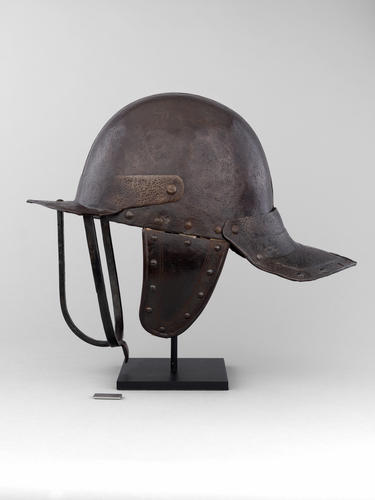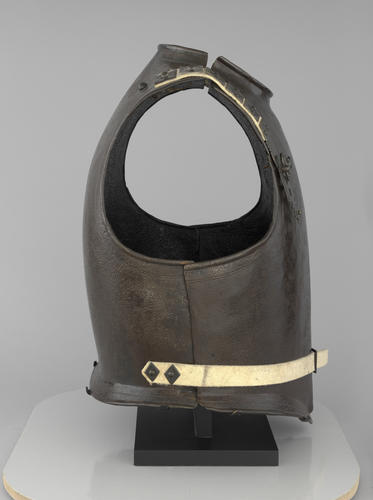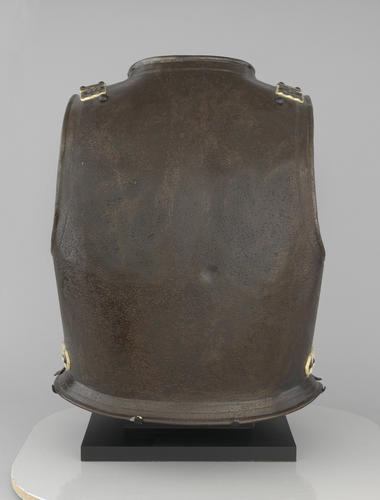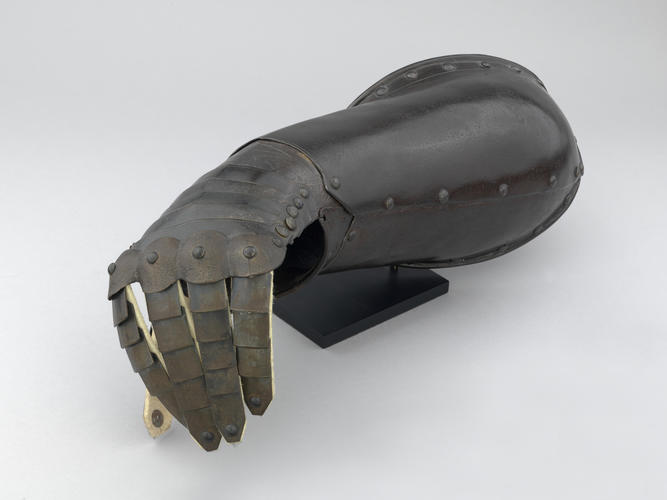Composite harquebusier’s armour about 1660-88
RCIN 28137
-
Composite harquebusier’s armour consisting of a triple-barred pot, a breastplate, a backplate and a long gauntlet for the left hand, all of blackened iron rough from the hammer.
This is the type of armour listed as an ‘Harquebuzere Armour’ in the 1650 Remain of the Tower Armouries. Contemporary military writers, such as Robert Ward, writing in 1639, described it as the equipment for the sort of light horseman, armed with an harquebus and two pistols, that was then replacing the heavily armoured cuirassier of the previous generation. Ideally, he should also have worn a coat of buff-leather, but it appears that few troops were so equipped. Armours of this type made to the pattern in the Ordnance Office could cost as little as 19s per suit, but others of officer’s quality cost £6.
The skull of the pot is struck with the royal cipher ‘IR’, in small letters under a closed crown, and the capital letters ‘RH’ under a crown of three fleurons. The ‘IR’ mark may have been intended to prevent re-sale of arms issued from His Majesty's Armoury. During the reign of Charles I, an order of 22 February 1628 had stipulated that 'all musketts and other armes to be henceforth issued out of his Majestie’s stoares for land service should be marked with C.R. …’. The letters ‘IR’ were presumably used during the reign of James II to indicate ownership by the Crown in the same way.
Measurements: Pot: overall height 31.8 cm, width of skull 17.5 cm, depth of skull 24.2 cm; Breastplate: height from shoulders to bottom of waist-flange 49.7 cm; width beneath arm-openings 35.3 cm; Backplate: height from top of shoulders to bottom of waist-flange 44.1 cm; Gauntlet: length 54.6 cm.
Weights: Pot: 3.374 kg; Breastplate: 7.002 kg; backplate 7.002 kg; Gauntlet: 1.191 kg.
Tests undertaken by Dr Alan Williams on the skull of the pot and the breastplate show them to have microhardnesses in the ranges 163–172 VPH (average 168 VPH) and 141–163 VPH (average 152 VPH) respectively. The pot consists of a mild steel with a carbon content of perhaps about 0.3%. The fragmented nature of the pattern of carburised iron crystals (pearlite) making up that steel suggests that it underwent much hot working. The breastplate on the other hand is formed of layered wrought iron with small traces of carburised iron in one layer perhaps having a carbon content of 0.2% at some points. It is composed of at least four layers of iron forged together: presumably recycling old iron to make cheap thick armour.
Text adapted from Arms and Armour in the Collection of Her Majesty The Queen: European Armour, London, 2016Provenance
The second mark on the skull is that of Richard Holden or Hoden, a London armourer who was apprenticed by the London Armourers’ Company in 1658 and made free of the Company by 1665. The skull might have formed part of the ‘Harquebuss Armour plain & Sanguined Lyned wth Crimson Satin’ delivered by Holden at a cost of £25, ‘for ye Service of his Mats owne Body’ on 4 May 1687.
It has been speculated that the armour may have been one of the two suits recorded in James II's post-mortem inventory of 1701, but it is difficult to see how it could have found its way back to the Tower from France. Judging from its quality, it is likely to be one of the less expensive armours that Holden is known to have made.
The armour was at one time described as that of Henry Stewart, Lord Darnley (1545–67), the consort of Mary Queen of Scots, and latterly as the second armour made by Richard Holden for James VII and II. A guidebook to the Palace of Holyroodhouse published in 1818 describes the armour of Henry Darnley as being ‘shewn in the room from which Rizzio was dragged out to be murdered’. This armour is illustrated in that room, known as ‘Queen Mary’s Closet’, in a lithograph by Samuel Dunkinfield Swarbeck, dated November 1837. -
Creator(s)
(nationality) -
Medium and techniques
Category
Object type(s)














